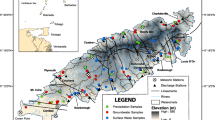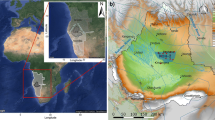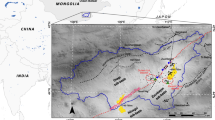Abstract
Parsimonious groundwater modeling provides insight into hydrogeologic functioning of the Nubian Aquifer System (NAS), the world’s largest non-renewable groundwater system (belonging to Chad, Egypt, Libya, and Sudan). Classical groundwater-resource issues exist (magnitude and lateral extent of drawdown near pumping centers) with joint international management questions regarding transboundary drawdown. Much of NAS is thick, containing a large volume of high-quality groundwater, but receives insignificant recharge, so water-resource availability is time-limited. Informative aquifer data are lacking regarding large-scale response, providing only local-scale information near pumps. Proxy data provide primary underpinning for understanding regional response: Holocene water-table decline from the previous pluvial period, after thousands of years, results in current oasis/sabkha locations where the water table still intersects the ground. Depletion is found to be controlled by two regional parameters, hydraulic diffusivity and vertical anisotropy of permeability. Secondary data that provide insight are drawdowns near pumps and isotope-groundwater ages (million-year-old groundwaters in Egypt). The resultant strong simply structured three-dimensional model representation captures the essence of NAS regional groundwater-flow behavior. Model forecasts inform resource management that transboundary drawdown will likely be minimal—a nonissue—whereas drawdown within pumping centers may become excessive, requiring alternative extraction schemes; correspondingly, significant water-table drawdown may occur in pumping centers co-located with oases, causing oasis loss and environmental impacts.
Résumé
Une modélisation simplifiée de la nappe donne un aperçu du fonctionnement hydrogéologique du Système Aquifère Nubien, le plus grand aquifère non alimenté du monde (Tchad, Egypte, Lybie, Soudan). Les problèmes classiques liés à la ressource en eau souterraine existent (amplitude du rabattement et rayon d’influence des stations de pompage), avec des questions de gestion internationale coordonnée des rabattements transfrontaliers. Le Système Aquifère Nubien est épais dans sa plus grande partie, il contient une nappe de grande qualité mais reçoit une recharge insignifiante, de sorte que la disponibilité de la ressource en eau est limitée dans le temps. Les données sur l’aquifère modélisé font défaut pour ce qui est de la réponse à grande échelle, elles fournissent seulement des informations autour des pompages. Des données transposées fournissent une base essentielle pour la compréhension de la réponse régionale. L’abaissement du niveau de la nappe holocène depuis la fin de la période pluvieuse précédente, il y a des milliers d’années, conduit aux oasis et sebkha actuelles, lieux où la surface de la nappe recoupe la surface du sol. La baisse est contrôlée par deux paramètres régionaux, la diffusivité hydraulique et l’anisotropie verticale de la perméabilité. Les données secondaires qui fournissent un aperçu sur le fonctionnement sont les rabattements près des stations de pompage et l’âge isotopique des eaux souterraines (un million d’années en Egypte). Le modèle tridimensionnel résultant, structuré de façon fortement simplifiée cerne l’essentiel du comportement de l’écoulement souterrain régional du Système Aquifère Nubien. Le modèle prévisionnel informe le gestionnaire de la ressource que le rabattement transfrontalier sera vraisemblablement minimal—un non problème—quoique le rabattement autour des stations de pompage puisse devenir excessif, nécessitant des schémas alternatifs de prélèvement et qu’un rabattement significatif puisse se produire autour des stations de pompages localisées dans les oasis, provoquant leur ruine et des impacts environnementaux.
Resumen
Un escaso modelado del agua subterránea proporciona una visión del funcionamiento hidrogeológico del Sistema Acuífero Nubio (NAS), el mayor sistema de agua subterránea no renovable del mundo (en Chad, Egipto, Libia, Sudan). Existen temas clásicos del recurso de agua subterránea (magnitud y extensión lateral del descenso del nivel de agua próximo a centros de bombeo) con cuestiones de manejo internacional conjunto en relación con el descenso del nivel de agua transnacional. Mucho del NAS de gran espesor, contiene agua subterránea de alta calidad, pero recibe una recarga insignificante, de manera que la disponibilidad del recurso agua está limitada en el tiempo. Se carece de datos informativos en relación a su respuesta a gran escala, proporcionándose sólo información a escala local cerca de los bombeos. Los datos de proximidad proporcionan un soporte primario para entender la respuesta regional. El descenso del nivel freático Holoceno a partir del período lluvioso previo, después de miles de años, resulta en localizaciones actuales de oasis/sabkha donde el nivel freático todavía intersecta la superficie del terreno. El descenso del nivel de agua es controlado por dos parámetros regionales, la difusividad hidráulica y la anisotropía vertical de la permeabilidad. Datos secundarios que proporcionan un conocimiento son los descensos del nivel del agua cerca de los bombeos y las edades isotópicas del agua subterránea (aguas subterráneas de un millón de años en Egipto). La representación resultante, fuerte y simplemente estructurada del modelo tridimensional captura la esencia del comportamiento del flujo regional de agua subterránea del NAS. Los pronósticos del modelo aportan al manejo del recurso ya que el descenso del nivel de agua transnacional será probablemente mínimo—no problemático—mientras que el descenso dentro de los centros de bombeo pueden convertirse en excesivo, requiriendo esquemas de extracción alternativos, y un descenso significativo del nivel freático puede ocurrir en los centros de bombeo localizados en coincidencia con los oasis, causando la pérdida de oasis e impactos ambientales.
摘要
的地下水模拟论述了世界上最 大的不可更新的地下水 系统--(乍得、埃及、利比亚和苏丹的)努比亚含水层系统的水文地质情况。典型的地下水资源问题与有关跨国界抽水的联合的国际管理问题共存。大部分努比亚含水层系统很 厚,包含高质量的地下水,但是接受很少的补给,因此水资源可用量有 时间上的限制。有关大规模响应方面的含水层资料匮乏,只有抽水井附近的局部 规模的信息。替代性资料为了解区域 响应提供了主要支持。从前一个洪积期全新世水位下降,几千年后导致形成了目前的绿洲/盐沼,这里的水位仍然贯穿地面。消耗受两个 区域参数 控制,水利扩散系数和渗透的垂直各向异性。次级资料为水泵附近的抽水资料及同位素地下水年龄(埃及百万年的地下水)。合成、牢固、简单结构的三维模型获得了努比亚含水层系统区域 地下水 水流特性。模型预测结果告知了资源管理部门,跨国界水位下降可能很小-不是个问题—而抽水中心 分内的下降可能过度,需要采取更替抽水的 方案,重大的 水位下降可能出现在抽水中心—与绿洲在同一位置,引起绿洲萎缩和 环境影响。
Resumo
A modelação parcimoniosa de águas subterrâneas fornece perceções sobre o funcionamento hidrogeológico do Sistema Aquífero Núbio (SAN), o maior sistema de água subterrânea não renovável do mundo (Chade, Egito, Líbia, Sudão). Neste sistema existem os problemas clássicos dos recursos hídricos subterrâneos (magnitude e extensão lateral do rebaixamento nas proximidades de centros de bombeamento), associadas a questões de gestão internacionais que dizem respeito a rebaixamentos transfronteiriços. Grande parte do SAN é de grande espessura, contendo águas subterrâneas de alta qualidade, mas recebe uma recarga insignificante, apresentando portanto uma disponibilidade hídrica temporalmente limitada. Há falta de dados que permitam prever respostas do aquífero a grande escala, providenciando apenas informações a escala local, na vizinhança dos pontos de bombeamento. Os dados de proximidade às captações não permitem a avaliação da resposta regional: o rebaixamento do nível freático do Holocénico a partir do período pluvioso anterior, após milhares de anos, resulta na localização atual dos oásis/sabkha, onde o nível freático ainda interseta a superfície. O grande exaurimento é controlado por dois parâmetros regionais, a difusividade hidráulica e a anisotropia da permeabilidade vertical. Os dados secundários que fornecem informações são os rebaixamentos perto dos pontos de bombeamento e as idades das águas subterrâneas estimadas por métodos isotópicos (da ordem dos milhões de anos no Egito). A forte representação da estrutura simples do modelo tridimensional capta o fundamental do comportamento do fluxo regional de águas subterrâneas do SAN. Previsões do modelo de gestão de recursos informam que os rebaixamentos transfronteiriços serão provavelmente mínimos—um não problema—enquanto os rebaixamentos na área de influência dos centros de bombeamento podem tornar-se excessivos, necessitando de esquemas de extração alternativos, e significativos nos centros de bombeamento co-localizados em zonas de oásis, causando perdas e impactes ambientais nesses oásis.
















Similar content being viewed by others
References
Bakhbakhi M (2004) Hydrogeological framework of the Nubian Sandstone Aquifer System. In: Appelgren B (ed) Managing shared aquifer resources in Africa. ISARM-Africa. IHP-VI, Series on Groundwater no. 8. UNESCO, Paris, pp 177–201
Brinkmann PJ, Heinl M (1986) Numerical ground water model, Berliner Geowissenschaflige Abhandlungen, Reihe A/Band 72. In: Thorweihe U (ed) Impact of climatic variations on East Saharan groundwaters: proceeding of a workshop on hydrology. Special Research Project Arid Areas, Technical University, Berlin, May 20–22, 1985, Reimer, Berlin, pp 135–155
Brinkmann PJ, Heinl M, Holländer R, Reich G (1987) Retrospective simulation of groundwater flow and transport in the Nubian Aquifer System, Berliner Geowissenschaflige Abhandlungen, Reihe A/Band 75.2. In: Klitsch E, Schrank E (eds) Research in Egypt and Sudan, Sonderforschungsbereich 69, Projektbereich B: results of the Special Research Project Arid Areas, period 1984–1987. Reimer, Berlin, pp 465–516
CEDARE (Mohamed Bakhbakhi, Regional Coordinator) (2001) Regional strategy for the utilisation of the Nubian Sandstone Aquifer System, vols 1–4 and annexes 1–2. Centre for Environment and Development of the Arab Region and Europe (CEDARE), Cairo
Du X (2003) Realization of radio-krypton dating with an atom trap. PhD Thesis, Northwestern University, Evanston, IL, 116 pp
Ehlers J, Gibbard PL, Hughes PD (2011) Quaternary glaciations: extent and chronology, vol 15, chap 1: a closer look. Developments in Quaternary Science, Elsevier, Amsterdam, 1126 pp
Froehlich K, Aggarwal PK, Garner WA (2007) An integrated approach in evaluating isotope data of the Nubian Sandstone Aquifer System (NSAS) in Egypt (IAEA–CN–151/147). In: Advances in isotope hydrology and its role in sustainable water resources management IHS (IHS-2007) Advances in isotope hydrology and its role in sustainable water resources management (IHS-2007). Proceedings of a symposium in Vienna, vol 1. Vienna, May 21–25, 2007, IAEA, Vienna, pp 31–46
Gossel W, Ebraheen AM, Wycisk P (2004) A very large scale GIS-based groundwater flow model for the Nubian sandstone aquifer in Eastern Sahara (Egypt, northern Sudan and eastern Libya). Hydrogeol J 12:698–713
Gossel W, Sefelnasr A, Wycisk P (2010) Modelling of paleo-saltwater intrusion in the northern part of the Nubian Aquifer System, Northeast Africa. Hydrogeol J 18(6):1447–1463
Harbaugh AW, Banta ER, Hill MC, McDonald MG (2000) MODFLOW-2000, the US Geological Survey modular ground-water model: user guide to modularization concepts and the ground-water flow process. US Geol Surv Open-File Rep 00–92, 121 pp
Heinl M, Brinkman PJ (1989) A groundwater model of the Nubian Aquifer System. Hydrol Sci J 34(4):425–447
Heinl M, Holländer R (1984) In: Klitsch E, Said R, Schrank E (eds) Some aspects of a new groundwater model for the Nubian Aquifer System, Berliner Geowissenschaflige Abhandlungen, Reihe A/Band 50: results of the Special Research Project Arid Areas, Period 1981–1984 (Sonderforschungsbereich 69). Reimer, Berlin, pp 221–231
Heinl M, Thorweihe U (1993) Groundwater resources and management in SW Egypt, In: Geopotential and ecology: analysis of a desert region. Supplement 26, Catena, Cremlingen-Destedt, Germany, pp 99–121
Hill MC, Banta ER, Harbaugh AW, Anderman ER (2000) MODFLOW-2000, the US Geological Survey modular ground-water model: user guide to the observation, sensitivity, and parameter-estimation processes and three post-processing programs. US Geol Surv Open-File Rep 00–184, 210 pp
Pachur H-J, Kröpelin S, Hoelzman P, Goschin M, Altman N (1990) Late Quaternary fluvio-lacustrine environments of western Nubia, Berliner Geowissenschaflige Abhandlungen, Reihe A/Band 120.1. Klitsch E, Said R, Schrank E (eds) Results of the special research project Geoscientific Problems in Arid and Semiarid Areas, period 1987–1990 (Sonderforschungsbereich 69). Selbstverlag, FU, Berlin, pp 203–260
Paillou P, Schuster M, Tooth S, Farr T, Rosenqvist A, Lopez S, Malezieux J-M (2009) Mapping of a major paleodrainage system in eastern Libya using orbital imaging radar: the Kufrah River. Earth Planet Sci Lett 277(3–4):327–333
Patterson LJ, Sturchio NC, Kennedy BM, van Soest MC, Sultan M, Lu Z-T, Lehmann B, Purtschert R, El Alfy Z, El Kaliouby B, Dawood Y, Abdallah A (2005) Cosmogenic, radiogenic, and stable isotopic constraints on groundwater residence time in the Nubian Aquifer, Western Desert of Egypt. Geochem Geophys Geosyst 6:Q01005, 19pp. doi:10.1029/2004GC000779
Pollock DW (1994) User’s guide for MODPATH/MODPATH-PLOT, version 3: a particle tracking post-processing package for MODFLOW, the US Geological Survey finite-difference ground-water flow model, chap 6. US Geol Surv Open-File Rep 94–464
Salem O, Pallas P (2004) The Nubian Sandstone Aquifer System (NSAS). In: Appelgren B (ed) Managing shared aquifer resources in Africa. ISARM-Africa. IHP-VI, Series on Groundwater no. 8, UNESCO, Paris, pp 19–22
Sefelnasr AM (2007) Development of groundwater flow model for water resources management in the development areas of the western desert, Egypt. PhD Thesis, Martin Luther University, Halle-Wittenberg, Germany, 173 pp. http://sundoc.bibliothek.uni-halle.de/diss-online/07/07H178/prom.pdf. Accessed 17 August 2013
Sturchio NC, Du X, Purtschert R, Lehmann BE, Sultan M, Patterson LJ, Lu Z-T, Müller P, Bigler T, Bailey K, O’Connor TP, Young L, Lorenzo R, Becker R, El Alfy Z, El Kaliouby B, Dawood Y, Abdallah AMA (2004) One million year old groundwater in the Sahara revealed by krypton-81 and chlorine-36. Geophys Res Lett 31:L05503. doi:10.1029/2003GL019234, 4p
Thorweihe U, Heinl M (2002) Groundwater resources of the Nubian Aquifer System NE Africa, modified synthesis. Observatoire du Sahara et du Sahel, Paris
Voss CI (2011a) Editor’s message: groundwater modeling fantasies —part 1, adrift in the details. Hydrogeol J 19:1281–1284
Voss CI (2011b) Editor’s message: groundwater modeling fantasies —part 2, down to earth. Hydrogeol J 19:1455–1458
Acknowledgements
This study is part of a medium-sized GEF (Global Environment Facility) project managed by UNDP (United Nations Development Programme) and IAEA (International Atomic Energy Agency) that concerns management of the Nubian Aquifer System (NAS) shared by Chad, Egypt, Libya and Sudan, under IAEA Project Number RAF/8/036: Sustainable Development of the Nubian Aquifer. Model development and associated analysis reported in this article were carried out under a cooperative research agreement between IAEA and the US Geological Survey (USGS). The bulk of model development and hydrogeologic analysis occurred during a 5-month period at IAEA in Vienna, Austria, in 2009. Additional analysis and reporting occurred thereafter at USGS. Throughout the IAEA period, the governments of each NAS country participated in the modeling effort with one or two hydrologists providing advice and feedback—Chad: I.M. Mohamed, Ministère de l’Environnement; Egypt: S. Afifi, UNDP, Egypt, and A. Khater, National Water Research Center; Libya: M. Bakhbakhi and L. Madi, General Water Authority; Sudan: A.A.M. Kheir and A.M. Osman, Ministry of Irrigation and Water Resources. Technical leadership at IAEA was provided by C. I. Voss, USGS. Technical modeling support was provided at IAEA by S. M. Soliman, National Water Research Center, Egypt. Stable and carbon isotope data interpretation was provided by K. Froehlich and P. Aggarwal, IAEA,as well as by the staff of the Isotope Hydrology Section, IAEA. GIS support as well as excellent reviews and thoughtful comments were provided by S. Terzer, IAEA, throughout the IAEA period. P. Aggarwal also provided overall project leadership for IAEA. P. Gremillion, IAEA, became the IAEA project manager late in the project period. Insightful expert technical reviews by four colleagues, Mohamed Bakhbakhi (General Water Authority, Libya), Wolfgang Gossel (Martin-Luther-University Halle-Wittenberg, Germany), Maksym Gusyev (GNS Science, New Zealand), and Edwin P. Weeks (USGS), allowed significant improvements to be made to this manuscript.
Author information
Authors and Affiliations
Corresponding author
Electronic supplementary material
Below is the link to the electronic supplementary material.
ESM
(PDF 3193 kb)
Rights and permissions
About this article
Cite this article
Voss, C.I., Soliman, S.M. The transboundary non-renewable Nubian Aquifer System of Chad, Egypt, Libya and Sudan: classical groundwater questions and parsimonious hydrogeologic analysis and modeling. Hydrogeol J 22, 441–468 (2014). https://doi.org/10.1007/s10040-013-1039-3
Received:
Accepted:
Published:
Issue Date:
DOI: https://doi.org/10.1007/s10040-013-1039-3




